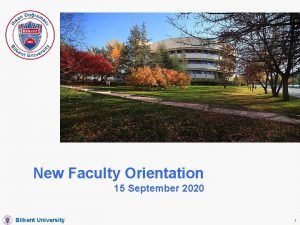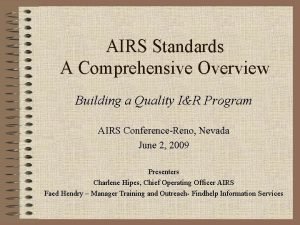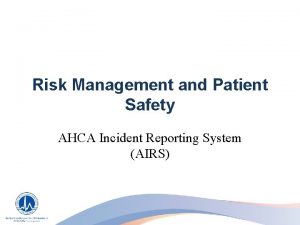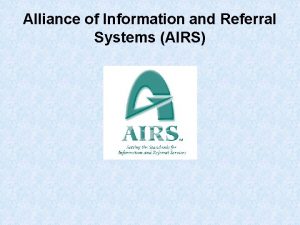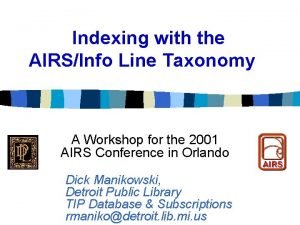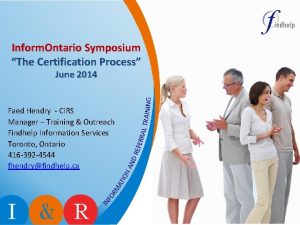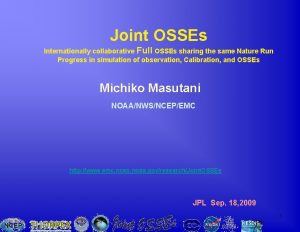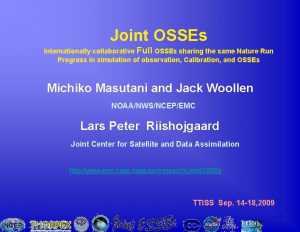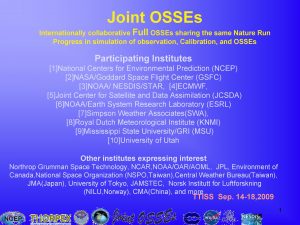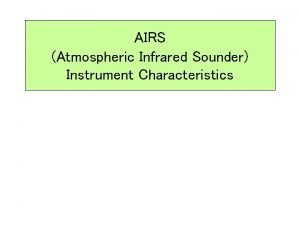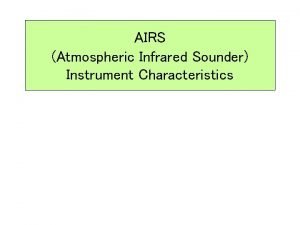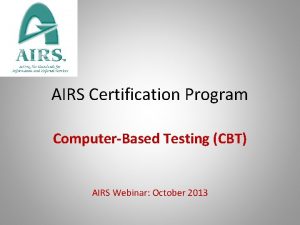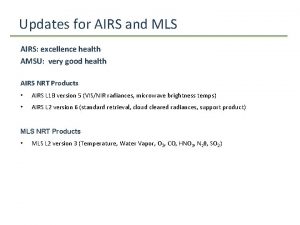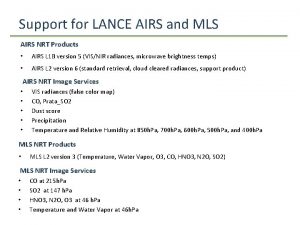Summary of OSSEs with AIRS 080110 AIRS Fast









![[General observation] More data is better and better model produce better results. Data must [General observation] More data is better and better model produce better results. Data must](https://slidetodoc.com/presentation_image_h2/1d0c2df25bd48fdd2885bcdd32d0d13d/image-10.jpg)

- Slides: 11

Summary of OSSEs with AIRS 080110

AIRS Fast Forward Model provided by UMBC. This fast transmittance model is based on methods developed and used by Larry Mc. Millan, Joel Susskind, and others. [Larry M. Mc. Millin et al. 1976, 1995]. Hybrid PFAAST/OPTRAN algorithm is developed with k. CARTA line by line model. The Fast Forward Models are developed based on the Prelaunch spectral response function. AIRS Radiance Simulation The simulation includes radiances of AIRS channels and microwave radiances for AMSU and HSB. The simulation result is in BUFR (binary universal form for the representation of meteorological data)

Radiative transfer model AIRS is a high spectral resolution spectrometer with 2378 bands in thermal infrared (3. 7 -15. 4 µm). These ranges have been specifically selected to allow determination of atmospheric temperature with an accuracy of 1°C in 1 km layers, and humidity with an accuracy of 20% in 2 km layers in the troposphere. AIRS is considered to be a high spectrum resolution infrared sounder which will act as a prototype for NPOESS. AIRS is selected as one of the instruments to be tested in OSSE experiments

Experiments Clonventional data are included for all experiments CONV (LNTV): T 62 L 28 conventional data only CTL: T 62 L 28 TOVS A. cl: T 62 L 28 data at every point. Thinning 250 km (old data) done by mistake but plotted. Acmt 1: T 62 L 28 Data at every point. Thinning 180 km (old data) Experiments using only center of golf ball A 4 b 3: T 62 L 28 Data at the center of golf ball. Thinning 180 km A 4 s 170: T 170 L 42 Data at the center of golf ball. Thinning 180 km A 6264: T 62 L 64 Data at the center of golf ball. Thinning 180 km ANST 160: T 62 L 28 model Data at the center of golf ball. Remove channels which are used for stratosphere Thinning 180 km Bias correction For spin up for the bias, assimilation is performmed without thnning (1 km thinning) for one week. Then recycle the bias correction and ran assimilation with thinning for the same period.

No Stratosphere T 62 28 L Thinned data No Sat T 62 64 level T 170 T 62 use all data Conventional + TOVS

Results The results are discussed for RMSE between analysis and NR in temperature. Mainly for 200 mb. 1. CTL. TOVS data shows significant impact in SH. Newtral impact in NH midllatitude over land small positive impact over ocean. 2. A. cl and Acmt 1 We found with AIRS data, RMSE from NR increase 30 S-60 S 2 -3 degree compared to CONV 3. A 4 b 3 We suspected using all point may be causing the inconsistency and AIRS data is simulated for center of golf ball. We found the RMSE increase conpared to Ac 1. 4. ANST 160 Stratosphere was removed because we suspected stratosperic data are badly simulated because nature run does not cover stratosphere well. The results showed with out stratosphere channel upper level analysis get significantly poor. 5. A 6264 Increasing vertical resolution to 64 level improve the analysis but still RMSE is worse than CONV. 6. A 4 s 170 T 170 L 42 model perform almost same as T 62 L 64.

RMSE are compared as Time averaged zonal mean RMSE take after zonal mean removed Time averaged zonal mean RMSE take after time mean removed Time averaged zonal mean bias Geographycal distrobution of time averaged RMSE 90 S-75 S : Any analysis with AIRS are better than CONV but worse than CTL. 70 S-30 S : CTL is much better than CONV Any analysis with AIRS are slightly worse than CONV 30 N-70 N: Any analysis with AIRS are much worse than CONV There are large bias for analysis with AIRS. CTL is slightly worse than CONV or simular Tropics: AIRS shows localized positive impact over ocean. Location of local positive impact depends on pressure levels.

More experiments Use Nature run orography instead of real orography Simulate clear sky radiance only Remove zonal mean and/or time mean from RMSE Still cannot get good results

![General observation More data is better and better model produce better results Data must [General observation] More data is better and better model produce better results. Data must](https://slidetodoc.com/presentation_image_h2/1d0c2df25bd48fdd2885bcdd32d0d13d/image-10.jpg)
[General observation] More data is better and better model produce better results. Data must be consistent and not just providing negative impact. If the data is simulated wrong, no data will give better results. [Speculation] RTTOV to simulate TOVS data, and OPTRAN for assimilation may be too optimistics for TOVS data. Using SARTA to simulate AIRS and OPTRAN to assimilate AIRS is too severe for AIRS If UMBC model is used for aissimilation, the results will be opposite.

More work Move on to the new nature run More detail study on diagnostic file Test with new GSI code.


